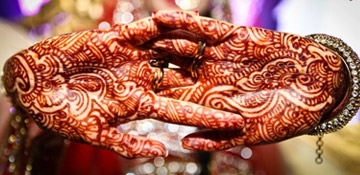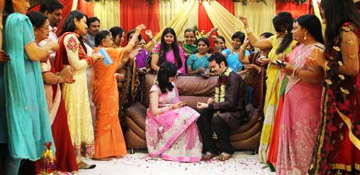If you witness the Wedding Ceremonies in India, you will be overwhelmed by the diverse shades of customs, religion and beliefs that these ceremonies offer. Called Panigrahana in Sanskrit and Vivah in Hindi, Indian weddings are a special affair, to say the least. In Indian culture, marriage is considered to be a union of two souls. Deemed a sacred affair, it is believed that marriage extends beyond a single life time and continues up to seven lives. The auspicious ceremony of marriage is taken to be 13th out of a total of 16 ceremonies in one’s life. Indian marriages are solemnized according to the VEDAS, Hindu religion’s sacred scriptures. Most of these Indian wedding rituals have regional traditions as their base. However, the common tie amongst all these wedding rituals is the fun as well as the excitement which form an integral part. One of the important Post Wedding Ceremonies in India is the Vidai Ceremony.
Indian Vidai Ceremony symbolizes reaching the end of the marriage. Vidai Ceremony in India is an event where emotions run high. It is very common to find the bride’s family members become pretty sentimental along with her friends as well as the relatives. Vidai Ceremony of India symbolizes a new journey for the bride as she departs from her parents’ house to go with her husband. A new life replete with new hopes and dreams beckons her. Vidai Ceremony in India is an affair of both joy and sorrow for the bride. During Indian Vidai Ceremony, the bride’s father formally gives away his daughter to her husband and asks him to protect and take care of his loving daughter.
The funny side of the Vidaai Ceremony in India is that it brings booty for certain people like the sister in-laws. A part of the Indian wedding ceremony is hiding the groom’s shoes subsequent to the marriage ceremony. Generally, the onus of this task rests on the shoulders of the sister in-laws. The sister in-laws, also called saalis, get a variety of gifts like kalichari, a ring made of gold or silver, cash or some other gifts in kind for returning the groom’s shoes.
Nevertheless, the focus of Indian Vidaai Ceremony is on the bride. As she leaves the cherished home of her parents, she hugs her friends and some of the family members. Touching the feet of the elderly and seeking their blessings is also a part of Vidaai. As the bride steps out of the entrance of her house, she throws back a few handfuls of rice over the head as a sign of opulence and wealth. This custom suggests that she is paying her parents back whatever they have given her all these years. At the same time, she is also praying for the prosperity to flourish in this house which was her abode since her birth.
In the final stages of the Indian Vidaai Ceremony, the newly wed couple sits in the car. The brothers and cousins of the brides give a bit of push to the car. It signifies the fact that they have given their sister a push ahead in her new life. Once the last car of the convoy starts, the bride’s family and friends throw coins on the road to thrust aside the evil. In many cases, the younger sister or brother accompanies the bride to her new house to provide her moral support. In South India, the Vidaai Ceremony is called by the name of Kshemadandulu.




